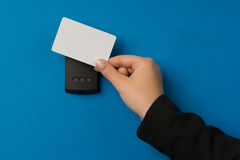|
RFID System
The gated community where I live implemented an RFID system or Radio-Frequency Identification for gate entry. In the past, the residents of my community entered a four digit code to raise the security bar and used a remote control to open the big iron gate. The security problem with this type of access to the community was that residents shared the four digit code with their friends and family and purchased additional remote controls to allow non-residents to enter the community without registering with the community security personnel. As the security of access to our community became somewhat out of control and the Homeowners Association had excess cash in their annual budget, the community decided to invest the extra cash in a better gate security system and assumed the cost of the RFID technology. The association selected the RFID system as the technology to control our gate entry because RFID security is much more superior compared to the security our old system provided. So, they picked a RFID company to implement the technology and provided RFID tags to all residents to be installed inside their vehicles at the top of the windshield. I like the RFID gate entry technology because no longer do I need to roll my car window down in a rainy day to enter the code at the community entrance, however, as you may have guessed, we now have to address the new challenges related to RFID security. Also, the RFID technology just like any other technology is not error free and from time to time, the gates would not open for whatever reason. Let’s further discuss the RFID technology and its security risks: What is RFID? RFID consists of a RFID reader, RFID antenna and RFID tag. The tag has stored information relevant to the identity of the object, person, animal or any thing else where the tag has been incorporated. The reader uses the information embedded in the tag to identify the object or the person through radio waves. The RFID range capacity differs from one RFID system to another and can be set to desired distances from a few inches to a few feet away from the RFID reader. RFID tags can be passive, active or semi-active which are battery assisted. Without going too deep into the details of the RFID technology, passive tags are the ones that were installed in my community. Passive RFID tags have no internal power supply. The electrical current induced in the antenna by the incoming radio frequency signal provides just enough power for the tag to power up and transmit a response. Most passive tags signal by backscattering the carrier wave from the reader. The antenna is designed both to collect power from the incoming signal and also to transmit the outbound signal. The RFID system has been widely used for many reasons including RFID passports also known as e-passports to keep track of a person’s travel history, although, the photo page still includes the photo and physical characteristics of the person. The technology has also been used for inventory tracking such as books in the library, student cloths and backpacks, animal and person identification, supply chain management, toll collection and electronic payments, and vehicle identification for gate entry. As I mentioned, RFID security poses new sets of challenges. Aside from availability risk, which appears to be a more common risk than traditional identification and access systems such as my old gate entry system, the main security risk is the unauthorized identification. With our old gate entry system, unauthorized access was limited to the residents’ friends and family members who were willingly shared access, however, with RFID, unauthorized access is granted to whomever possesses the RFID tag. A recent event confirmed my risk analysis. I was told that a valet parking person working for a wedding hall took control of a guest’s car during the wedding and drove to the guest’s house and stole all valuables in the house. I’m not sure how the thieves discovered the guest’s home address, possibly via a mail left in the car, however, with the installed RFID tag, a garage door opener in the car, and home keys attached to the car key, the home robbery was easy while neighbors would be less suspicious with the resident’s car parked in the front of the house or in the garage during the robbery. The best RFID security solution would be to disable the RFID tags while the RFID tag is out of our control for an extended period of time such as when our RFID tagged car is dropped off within the proximity of our homes for car repairs and valet parking. I acknowledge how inconvenient this might become when others manage the RFID system or when our RFID tags are sticked to the windshield, but balancing improved and convenient security technology with reduced security technology risks is sometimes challenging. In the case of our community, the installation of the RFID technology improved prior security challenges and made it more convenient for the residents, however, it introduced additional security risks. Being able to remove the RFID tags has advantages and disadvantages. On the positive side, tags can be removed when the car is left unattended, but tags can also be lost if they are removed which can add more security risks. I guess the combination of RFID tags and our old system's 4 digit code might be the best security option. |

